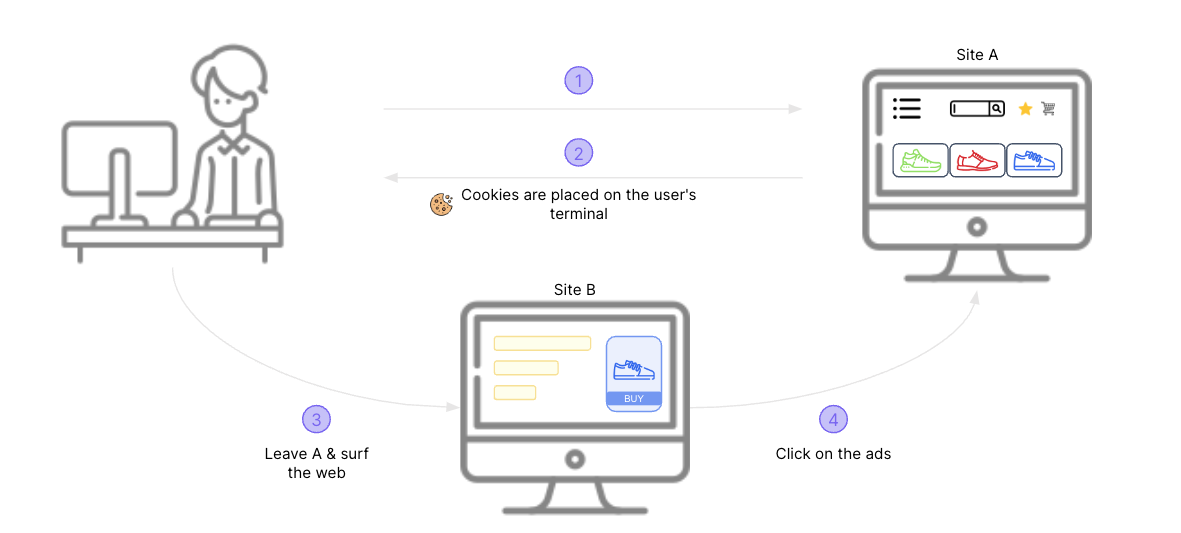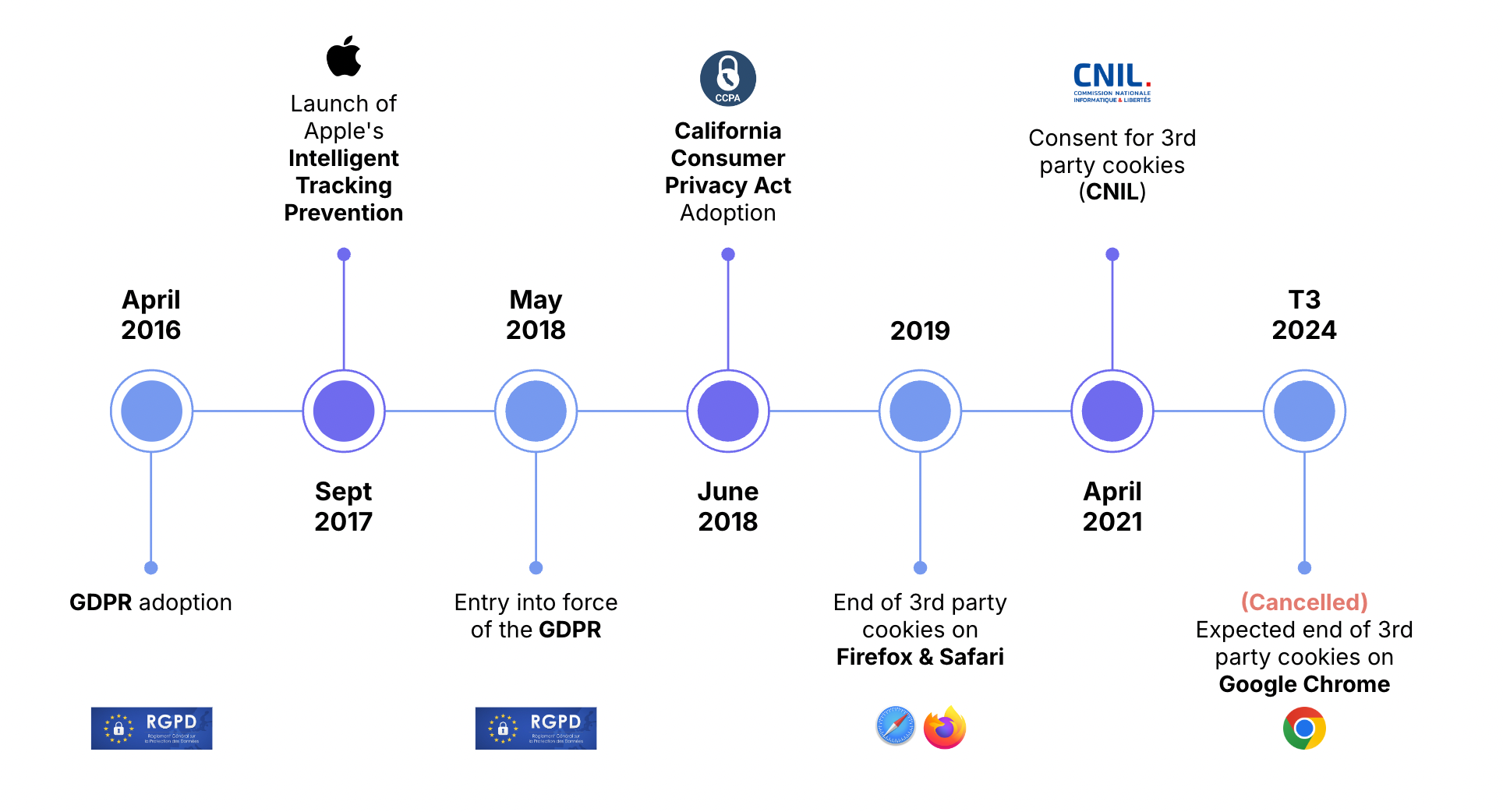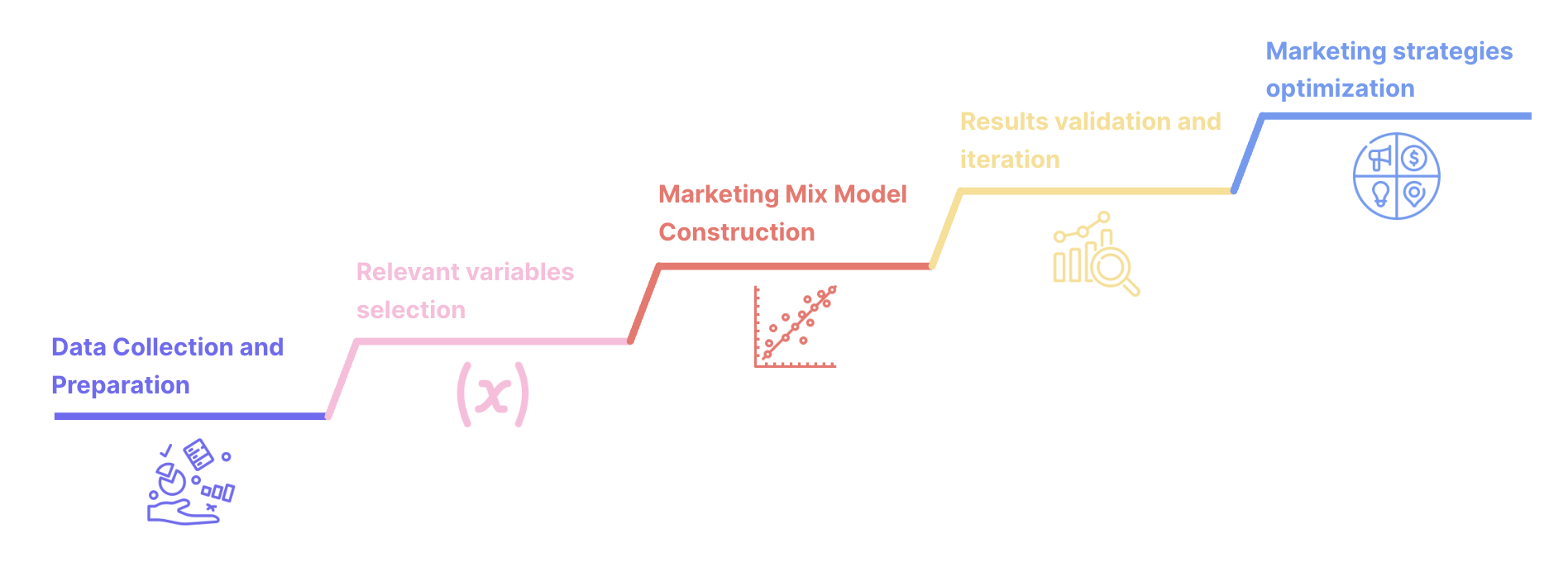
End of cookies: New marketing strategies
8min • Last updated on Nov 3, 2025

Alexandra Augusti
Chief of Staff
Following announcements by various browsers to phase out third-party cookies, a major shift is underway in digital marketing. Although Google Chrome reversed its decision by canceling the removal of third-party cookies, this reversal doesn't mean third-party cookies are a viable long-term solution.
Third-party cookies, generally used for targeting purposes, can no longer be the sole method for conducting marketing.
The move towards a “cookieless” environment isn't new and stems from the growing demand for greater privacy and respect for user consent online.
The various restrictions on third-party cookies raise an important question:
How can marketers continue to deliver a personalised experience that respects users' privacy?
👉🏼 In this article, we will look at practical alternatives to help ensure a smooth transition to an era of effective digital advertising without compromising privacy, addressing the challenges of the cookieless environment.
The gradual end of the third-party cookie era
As the web has evolved, third-party cookies have played a significant role in the world of digital marketing. These small scripts, placed on your devices by entities you haven't directly visited, allow advertisers to personalise ads based on your browsing habits, interests, geographic location, or purchase history. For example, when reading an article on a news site, it’s common for a third-party cookie to be used by an advertiser to target their ads.

Third-party cookies are used to track online behaviour and retarget customers
However, the use of these third-party cookies raises significant concerns regarding privacy protection as they enable tracking of a person's browsing across different sites. Additionally, they collect personal information, posing risks to individual freedom and security.
In light of these concerns, the web industry is moving towards limiting or even eliminating third-party cookies.
Here are the key moments marking this shift:
In 2010, the first ad blockers appeared. The most restrictive ones prevented tags from firing and blocked the installation of third-party cookies on users’ devices.
In 2017, Apple introduced its Intelligent Tracking Prevention (ITP) system on Safari, limiting access to third-party cookies and reducing their lifespan to 24 hours. As a result, retargeting was time-limited, making it difficult to identify a user returning to a site within a few days.
Since 2020, Apple blocks all third-party cookies by default.
2018: the entry into force of the GDPR and several decisions by data protection authorities strengthen user consent requirements, severely limiting the use of cookies for advertising tracking.
In 2019, Mozilla followed suit with the default blocking of third-party cookies in Firefox, emphasising user privacy protection.
In 2020, Google announced its plan to eliminate third-party cookies on Chrome, the market-dominant browser, by 2022. The company then introduced its Privacy Sandbox, an initiative designed to replace third-party cookies with more privacy-preserving solutions. It relied on anonymous user groups and contextual signals.
Various delays occurred, and the deadline was pushed back multiple times before being fully cancelled in 2025 amid an ongoing antitrust investigation.

Timeline: how third-party cookies are scrambling
The inherent limits of using cookies for advertising
While the decline of third-party cookies appears to be a challenge for marketers, it’s important to note that these same cookies already revealed certain limitations in the advertising context. Indeed, third-party cookies are not without flaws and did not guarantee an optimal advertising strategy that respected users.
Here’s an overview of the main disadvantages associated with third-party cookies:
Third-party cookies are not suitable for multi-device use: They do not inherently allow tracking a user across different devices (PC, smartphone, tablet...), complicating the tracking of customer journeys and the attribution of advertising conversions.
💡 Note that if a person is logged into the same account on different devices, reconciliation is still possible.
Third-party cookies can be easily blocked or deleted: Users can resort to ad blockers, incognito mode browsers, or modify privacy settings to prevent the installation of third-party cookies on their browser, reducing the reach and accuracy of ad campaigns.
Third-party cookies negatively impact website performance: Requiring additional network requests, third-party cookies increase page load times, potentially harming user experience and SEO rankings of websites.
Third-party cookies are not under the control of advertisers: As they belong to advertising platforms, third-party cookies reduce advertisers' ability to directly control their data, forcing them to rely on intermediaries for targeting and campaign performance analysis. Therefore, they cannot directly choose whom to target in their media strategies and are subject to the decisions of advertising giants.
We are thus witnessing a gradual shift on the web towards a model without third-party cookies, disrupting long-standing practices in digital marketing. Google's announcement doesn’t change this, as both users (through ad blockers and consent) and other browsers are blocking these cookies.
Today, over 70% of browsing is no longer associated with third-party cookies.
In a way, third-party cookies were not the panacea for online marketing.
Their depreciation can be seen by advertisers as an opportunity to rethink strategies in a more effective and privacy-first way.
So, what are the cookieless alternatives, and how can they be adopted?
👉🏼 We will explore these questions in the following sections of this article.
What are the alternative solutions to third-party cookies?
With the gradual decline in the use of third-party cookies, marketing professionals, publishers, and advertising platforms are compelled to seek alternative means to continue offering targeted, personalised, and effective advertising. Several solutions are available, each with its own advantages and challenges.
If you need a more detailed content, do not hesitate to download our complete guide to third-party cookies!
👇

2025 complete guide to third party cookies
Personalised Targeting Without Cookies
This method aims to identify users without relying on third-party cookies, using other techniques such as fingerprinting, authentication, universal IDs, or cross-site IDs. These techniques facilitate recognising a user across different sites or devices and allow them to be served ads that match their profile and behavior.
However, it’s important to note that these strategies raise significant privacy concerns, as they involve collecting personal data without explicit user consent and may be challenged by regulatory actions or browser settings.
Cohort Targeting
Cohort targeting groups users based on shared traits or interests without individually identifying them. This allows targeting market segments while preserving individuals' anonymity. Google’s Privacy Sandbox is a notable example, aiming to replace third-party cookies with technologies based on anonymous user groups and contextual signals.
Despite its potential, this method is still in the testing phase and is struggling to convince. Questions persist regarding its effectiveness, its impact on competition, and its long-term viability given the continued use of third-party cookies in Chrome.
Contextual Targeting
Contextual targeting selects ads based on the content of the site visited by the user without using personal data. This approach ensures that ads align with the content viewed by the user, thus respecting their privacy. Although an older method, it’s regaining popularity in the face of third-party cookies' obsolescence.
However, it does not consider users' specific preferences or intentions, which can reduce its effectiveness compared to personalised targeting.
First-Party Data Collection with Advertising Platforms
This approach involves directly collecting user data through their consent, then transmitting it to advertising platforms for personalised ad targeting. First-party data, obtained directly by the site or application visited by the user, offers higher quality, precision, and privacy compared to third-party data.
However, this strategy requires a rich and qualified database, as well as compliance with data protection regulations.
Using First-Party Data in Advertising Platforms
Collecting data is crucial for better understanding your customers and determining which marketing strategies to implement... But it’s even better to use this data directly in advertising platforms!
For this purpose, most media platforms have developed Conversion APIs, allowing the transmission of any event data. This makes it possible to share 100% of the information (online and offline) with media platforms, optimising advertising algorithms.
First-party data strategies can help you save a lot of marketing budget!
Innovative new measurement methods
Third-party cookies were also used to measure the performance of marketing campaigns. New cookieless measurement methods are emerging today as essential solutions.
These approaches rely on advanced tools and statistical models to assess campaign effectiveness. For example, Marketing Mix Modeling (MMM) stands out by offering the ability to analyse the impact of various marketing channels on sales using aggregated and historical data.

Marketing Mix Modeling: detailed steps
This method is not only effective for calculating ROI (Return On Investment), but also helps optimise budget allocation.. However, it has certain limitations, such as its inability to measure short-term campaign effectiveness and to capture individual consumer journeys.
In a nutshell
The end of the third-party cookie era is a reality (despite Google's announcement!) that the digital world has been grappling with for some time, and this shift is accelerating as major browsers continue to phase out these trackers.
Advertisers are now compelled to reinvent personalised advertising methods to remain effective without infringing on users' privacy. Several strategies are emerging as alternatives to third-party cookies, including personalised targeting without cookies, cohort targeting, contextual targeting, injecting first-party data directly into platforms, and adopting new measurement approaches.
DinMo helps you activate your first-party data across all your marketing destinations to succeed in a cookieless world. Feel free to contact us to learn more!





















